A. INFANTRY
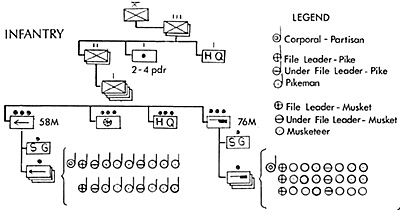 The standard Swedish infantry unit was the regiment. Brigades were only temporary units and were seldom used. Swedish infantry regiments consisted of two or three battalions of foot of 8-12 companies plus a regimental gun detachment of two-4 Pdr. and a regimental headquarters of 8 canons and approximately 30-50 men.
The standard Swedish infantry unit was the regiment. Brigades were only temporary units and were seldom used. Swedish infantry regiments consisted of two or three battalions of foot of 8-12 companies plus a regimental gun detachment of two-4 Pdr. and a regimental headquarters of 8 canons and approximately 30-50 men.
NOTE: in the, "SWEDISH INFANTRY", diagram I have given a tentative reconstruction of Gustavus Adolphus's infantry organization based on the following known facts.
- 1. Pikeman in the Swedish Army fought in 6 ranks.
2. Co. pay scale allows 2-sgt., 6-corp., 15-file leaders, 21-sub file leaders, 1-captain, 1-lt. and various admin. personnel.
3. It was customary for the musketeers to pass through the pikemen to advance to fire.
4. Musketeers in the Swedish Army fought in 3 ranks.
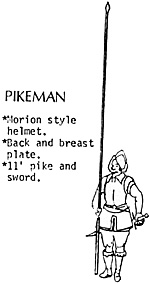 Thus a Swedish infantry company consisted of a platoon each of pikes and musketeers each led by a sergeant.
Thus a Swedish infantry company consisted of a platoon each of pikes and musketeers each led by a sergeant.
A company headquarters of a captain, a lieutenant, standard bearer and assistant, armorer and record keeper plus fifers, and drummers.
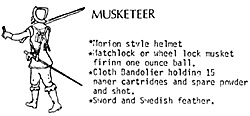 The company transportation platoon consisted of three wagons and miscellaneous personnel. Each platoon, pike and musket, consisted of three
squads each commanded by a corporal.
The company transportation platoon consisted of three wagons and miscellaneous personnel. Each platoon, pike and musket, consisted of three
squads each commanded by a corporal.
The pike squad consisting of two files each consisting of a file leader with two sub file leaders, and 6 pikemen.
The musket squad consisting of three files each of one file leader, one sub file leader and six musketeers.
B. ARTILLERY
Gustavus had caused all old cannon to be collected and recast into new standard cannon. By experimentation he had discovered that cannon could be considerably shortened and lightened without reducing their range or accuracy.
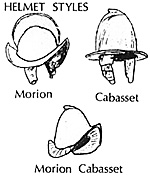 He standardized the nation's artillery into 4, 6, 12, and 24 pound guns of three catagories: siege, ship, and field. Further he standardized the gun carriages.
He standardized the nation's artillery into 4, 6, 12, and 24 pound guns of three catagories: siege, ship, and field. Further he standardized the gun carriages.
| SWEDISH GUN TUBE WEIGHTS | |||
|---|---|---|---|
| SIEGE | FIELD | #PDR. | BORE (in.) |
| 6,000 | 2,700 | 24 | 5 |
| 2,600 | 1,800 | 12 | 4 |
| 1,700 | 1,200 | 6 | 3.3 |
| NOTE:The 4 pdr. gun was the regimental gun. | |||
REGIMENTAL GUN
Gun tube weight = 400 lb.
Projectile wpinht = 4 lb.
Gun tube length = 3' 10"
Bore = 2.6"
Maximun rate of fire 8 rpm
Normal rate of fire 4 rpm
Canister range = 250-350 meters
Allocation = 2 guns per Swedish Infantry Regiment
Traction = 1 Horse or 4 men
NOTE: First gun to use fixed ammunition - a thin turned wooden case holding the projectile. It is actually capable of a greater rate of fire than the musket of the day.
C. CAVALRY
The Swedish Horse consisted of both cavalry and dragoons. The standard Swedish cavalry unit ias the regiment. Each regiment consisted of two or three battalions of cavalry and a regimental headquarters. It is not known if the cavalry had regimental guns attached, but it is assumed that they did not. Regimental headquarters consisted of from 30-50 men, approximately, and 8 wagons.
Each battalion consisted of 4 cavalry companies or cornets. The following is a listing of personnel in a cornet.
| NUMBER | TITLE | NUMBER OF HORSES |
|---|---|---|
| 1 | Captain | 4 |
| 1 | Ensign | 3 |
| 2 | Corporal | 2 |
| 1 | QM | 2 |
| 1 | Cleric | 1 |
| 1 | Chaplain | 1 |
| 1 | Provost | 1 |
| 1 | Barber | 1 |
| 1 | Farrier | 1 |
| 2 | Trumpeter | 1 |
| 102 | Privates | 1 |
| TOTALS | 115 | 125 |
It is assumed that the organization of the dragoons was similar.
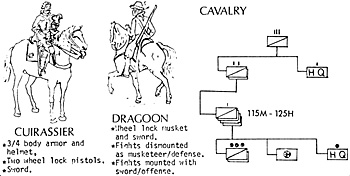
D. SWEDISH MERCENARY INFANTRY
The diagram given is that of Lord Ray at Breitenfeld. Apparently the mercenary infantry was organized into regiments of two battalions of four companies each, but that the Mercenary companies tended to remain all pike or all musket.
E. SWEDISH NAVY
In 1630 the Swedish Navy consisted of the following. (According to Dodge)
| SHIP | GUNS |
|---|---|
| Mercury | 32 |
| Apollo | 20 |
| Pelican | 20 |
| Andromeda | 18 |
| Rainbow | 13 |
| Stork | 12 |
| Parrot | 10 |
| Dolphin | 2 |
| Black Dog | 8 |
By 1632 the Swedish Navy had 5 admirals and 54 warships of 48-160 man crew each. Throughout the war in Germany the Swedish Navy maintained uncontested control of the Baltic.
F. TACTICS
Gustavus taught his musketeers to advance rapidly through the ranks of the pikemen and to fire in three ranks with the first rank kneeling so that the other two could fire ever them. He drastically reduced the amount of body armour worn, and continuously drilled his units in rapid maneuver. He taught the cavalry to charge home with the sword. Dragoons fought as infantry dismounted in the defense, and as light cavalry mounted in the attack. By his lightening of artillery and stress on maneuver he created field artillery.
All this doesn't seem too novel to us now, but in Gustavus's day artillery was an immovable object which merely fired a couple of shots before being captured by cavalry. Infantry fought in huge immovable Spanish Squares which simply battered each other until one couldn't stand it anymore. Cavalry was in the habit of charging until it was within 20 yards or so and then stopping to fire pistols at the enemy.
Gustavus's tactics demonstrated for the first time the value of maneuverability, and that the infantry's power lies in its shot, and cavalry in the shock of its charge.
BIBLIOGRAPHY
1. "Weapons and Tactics, Hastings to Berlin" by Jac. Weller C. 1966, St. Martin's Press
2. "Gustavus Adolphus" by Theodore Ayrault Dodge 1895, Boston: Houghton Mifflin
3. Gustavus Adolphus" By C.R.L. Fletcher C 1892, London
4. "Gustavus Adolphus and the Thirty Years War" By C.R.L. Fletcher C 1963, Capricorn Books N.Y.
5. "Gustavus Adolphus and the Struggle of Protestantism for Existance" By C.R.L. Fletcher
C 1390 G.P. Putnam's Sons N.Y.
6. "History of Gustavus Adolphus" By John L. Stevens C 1885, Richard Bentley and Son,London
7. "Gustavus Adolphus The Lion of the North" By Lt.-Gen Sir George MacMunn, C 1931
8. "War Through the Ages" By Lynn Montross C 1946, Harper & Brothers Publishing N.Y.
9. "Outlines of the World's Military History By W.A. Mitchell Military Services Publishing Co.
10. "The Thirty Years War" By C.V. Wedgwood c 1939, New Haven Yale University Press
More Swedish National Army of Gustavus Adolphus
-
Introduction
Recruitment and Engineering
Medical, Pay, Administration, and Supply
Organization and Tactics
Back to Table of Contents -- Panzerfaust #62
To Panzerfaust/Campaign List of Issues
Back to MagWeb Master Magazine List
© Copyright 1974 by Donald S. Lowry
This article appears in MagWeb (Magazine Web) on the Internet World Wide Web. Other military history articles and gaming articles are available at http://www.magweb.com